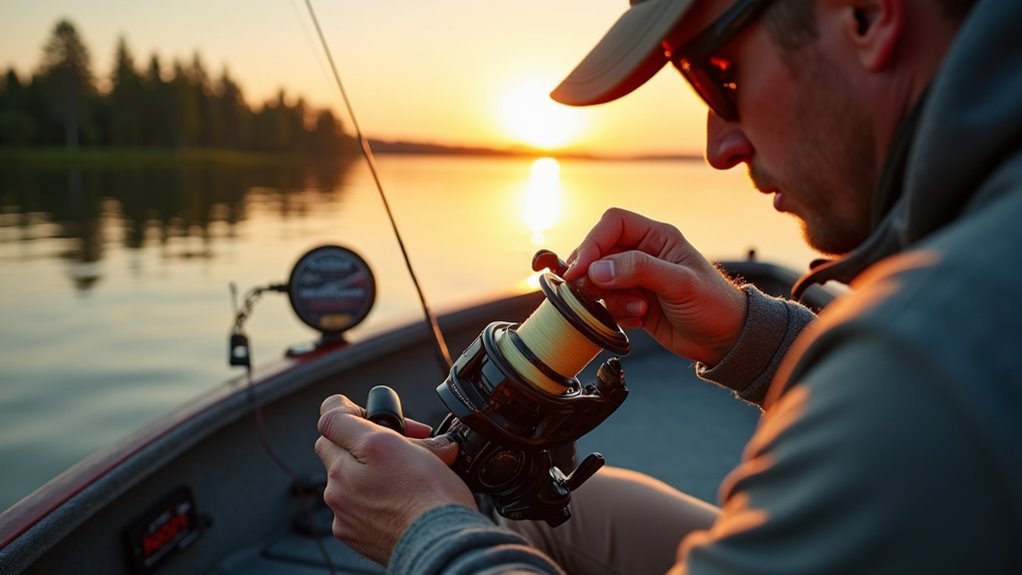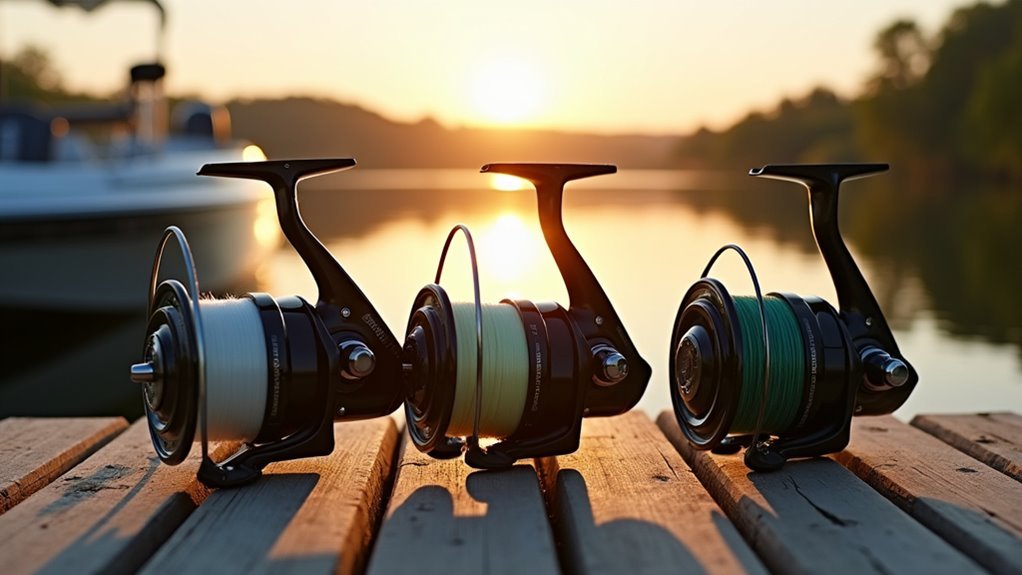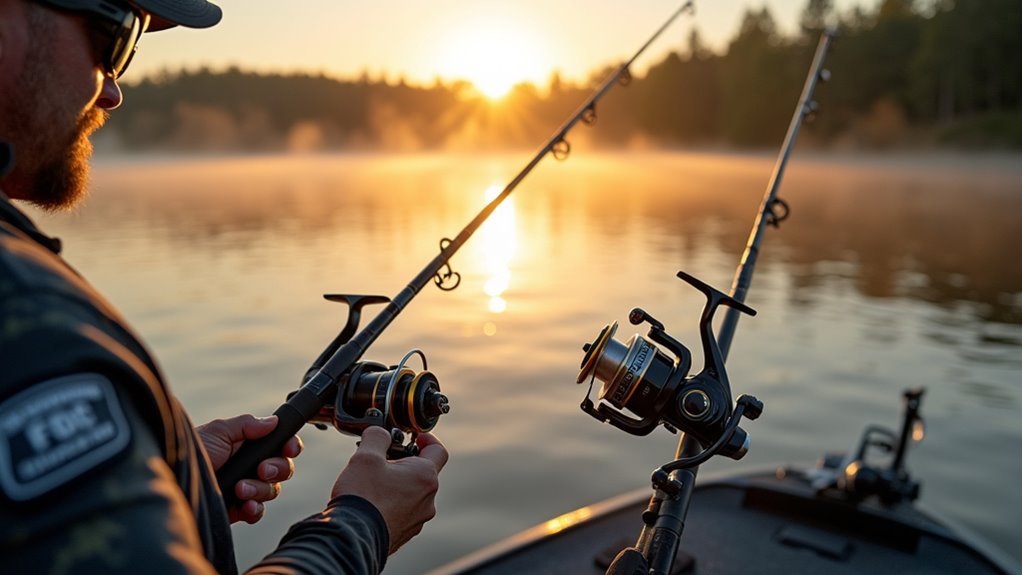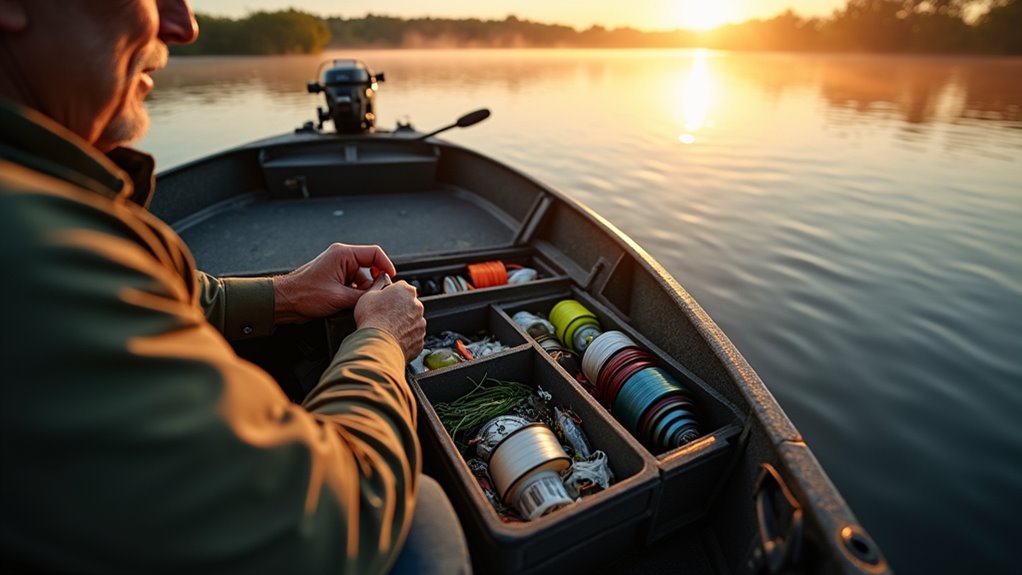We’ll catch more bass by matching our line to the situation. For clear water, lighter 6-10 lb test keeps things stealthy, while heavy cover demands 15-30 lb strength. Monofilament works great for topwater, fluorocarbon disappears underwater for finesse fishing, and braided line gives us muscle for thick vegetation. Don’t forget to pair spinning reels with lighter line and baitcasters with heavier options. The right line choice makes all the difference when that trophy strikes.
Understanding Pound Test Basics for Bass Fishing

Three essential numbers determine your bass fishing success: the pound test rating on your line. We’ve learned through countless sunrise casts that matching your line strength to your fishing situation makes all the difference.
For finesse baits with spinning reels, stick to 8-12 lb test. When you’re battling bass in heavy cover, bump up to 15-20 lb test. And those monster swimbaits? They demand 30-50 lb braided line.
Remember when I hooked that 7-pounder in thick lily pads? My 12 lb test snapped like thread! Now I always consider both my equipment and environment before selecting my line.
Matching Line Strength to Your Fishing Environment

While clear water demands stealthy approach with lighter lines, murky conditions tell a completely different story for your bass fishing success. We’ve learned this lesson countless times on the water – environment dictates your line choice.
| Water Condition | Cover Type | Recommended Line | Test Weight | Best Line Type |
|---|---|---|---|---|
| Clear | Minimal | Lighter | 6-10 lb | Fluorocarbon |
| Clear | Heavy | Medium | 12-15 lb | Fluoro/Braid |
| Stained | Minimal | Medium | 10-15 lb | Mono/Fluoro |
| Stained | Heavy | Heavy | 15-30 lb | Braid |
| Muddy | Any | Heavier | 15+ lb | Braid |
The Three Main Fishing Line Types Compared

Every bass angler faces a crucial choice when spooling up their reels – monofilament, fluorocarbon, or braided line? We’ve tested them all during countless dawns on misty lakes.
Monofilament’s the jack-of-all-trades – affordable, forgiving, and with decent invisibility, but it’ll absorb water and stretch when battling those trophy bass.
Fluorocarbon sinks naturally and practically disappears underwater – perfect for clear water when those lunkers get picky. It’s sensitive too!
Braided line’s our go-to for heavy cover. Nothing beats its strength-to-diameter ratio and zero stretch when that 5-pounder dives into submerged timber.
Spinning vs. Casting Reels: Choosing the Right Setup

When bass fishing success hangs in the balance, your choice between spinning and casting reels can make all the difference. We’ve found spinning reels perfect for beginners since they’re easier to handle and less prone to backlash. They excel with lighter lines (8lb or less) and finesse techniques.
Casting reels, our go-to for serious bass hunting, offer precision casting and higher gear ratios. I remember nailing a 6-pounder under a dock with my baitcaster when nothing else worked. They handle heavier lines beautifully and give you the power for bigger baits.
Line Selection Based on Lure and Technique

Three key factors determine the perfect line for your bass lures: technique, cover, and water clarity. When finesse fishing in clear water, we’ve found that 8-10 lb fluorocarbon gives you that invisible edge bass can’t detect.
For pitching jigs into thick brush, we’ll bump up to 15-20 lb test. Remember that time I lost a monster at Lake Fork because my line was too light? Won’t make that mistake again!
Topwater lures work best with monofilament’s floating properties, while braided line excels for deep cranking where sensitivity matters. Match your line to your mission!
Top Line Recommendations From Bass Anglers
Bass anglers we’ve met on the water have shared their go-to line choices over the years, and we’ve compiled them here. Whether you’re tackling weedy lakes or crystal-clear reservoirs, these recommendations have proven themselves time after time.
| Line Type | Pound Test | Best For |
|---|---|---|
| Fluorocarbon | 12-15 lb | Clear water, finesse techniques |
| Braided | 30-50 lb | Heavy cover, flipping/pitching |
| Monofilament | 10-12 lb | Topwater, crankbaits |
| Braided/Fluoro | 30/12 lb | Carolina rigs, drop shots |
| Fluorocarbon | 20 lb | Jigs, deep structure |
We’ve caught countless lunkers on these setups. Remember when we landed that 8-pounder in thick lily pads? Couldn’t have done it without 50-pound braid!
Frequently Asked Questions
How Does Water Temperature Affect Line Selection for Bass?
We find colder water requires more sensitive lines like fluorocarbon to detect subtle bites. In warmer temperatures, fish are more aggressive, so we can use heavier braided lines for stronger hooksets.
Can I Use the Same Line Year-Round for Bass Fishing?
Oh sure, we all love simplicity—one magic line for all seasons! We don’t recommend using the same line year-round as seasonal conditions demand different properties. Lighter lines for clear, cold water; heavier for warmer vegetation periods.
How Often Should I Replace My Fishing Line?
We recommend replacing your line every 3-6 months depending on use. If you notice fraying, memory, or reduced performance, it’s time for new line regardless of timing.
Does Line Color Actually Matter to Bass?
While bass can’t appreciate colors like we do, line visibility affects us most. In clear water, we’ll want transparent lines; in stained conditions, green tints blend better with the environment.
Are Budget Fishing Lines Effective for Serious Bass Anglers?
We’ve found budget lines can be effective for serious bass anglers. They’re not always as durable or sensitive as premium options, but many perform surprisingly well for everyday fishing situations.
Conclusion
We’ve journeyed from ultralight 8-pound test to beefy 20-pound braid, covering everything you need to know about fishing line. While beginners stick with mono, pros often reach for fluoro or braid. Your perfect line isn’t just about strength—it’s about matching your technique, environment, and quarry. We’ve caught monster bass on whisper-thin lines in clear water and hauled bruisers from thick cover with heavy braid. Now it’s your turn to make the connection.